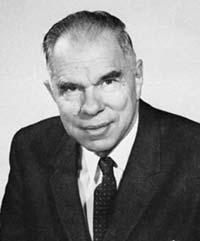 |  Glenn T. Seaborg Glenn T. Seaborg
born April 19, 1912, Ishpeming, Mich., U.S.
died Feb. 25, 1999, Lafayette, Calif.
Full name, Glenn Theodore Seaborg. American nuclear chemist best known for his work on isolating and identifying elements heavier than uranium. He was awarded the 1951 Nobel Prize for Chemistry (with Edwin Mattison McMillan). Element 106, seaborgium, was named in his honour.
Seaborg was educated at the University of California at Los Angeles (A.B., 1934) and the University of California at Berkeley (Ph.D., 1937). At Berkeley he was successively research associate, instructor, and assistant professor (193745), becoming professor of chemistry in 1946. He served as Berkeley's chancellor in 1958 - 61.
With his coworkers, Seaborg added (1940-55) ten new elements encompassing atomic numbers 94 -102 and 106, of which plutonium (94) is the best known because of its use as a nuclear explosive and for nuclear power. During World War II, which he spent as a section chief at the University of Chicago Metallurgical Laboratory, the first industrial production of plutonium was undertaken in newly devised uranium reactors, and Seaborg had the primary responsibility for isolating plutonium from the reaction products.
The other new elements were: americium (95), curium (96), berkelium (97), californium (98), einsteinium (99), fermium (100), mendelevium (101), nobelium (102), and unnilhexium (106). The prediction of the chemical properties and placement of these and many heavier elements in the periodic table of the elements was helped greatly by an important organizing principle enunciated by Seaborg in 1944 and known as the actinide concept. According to this concept, the 14 elements heavier than actinium belong in a separate group in the periodic table.
Seaborg was chairman of the Atomic Energy Commission from 1961 to 1971, and the American nuclear-power industry developed rapidly during that time. Seaborg returned to the University of California at Berkeley in 1971.
*Biography Books available - click here» |



